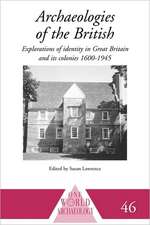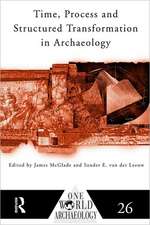Industrial Archaeology: Future Directions: Contributions To Global Historical Archaeology
Editat de Eleanor Casella, James Symondsen Limba Engleză Paperback – 3 mar 2005
| Toate formatele și edițiile | Preț | Express |
|---|---|---|
| Paperback (1) | 641.85 lei 6-8 săpt. | |
| Springer Us – 3 mar 2005 | 641.85 lei 6-8 săpt. | |
| Hardback (1) | 645.79 lei 6-8 săpt. | |
| Springer Us – 3 mar 2005 | 645.79 lei 6-8 săpt. |
Din seria Contributions To Global Historical Archaeology
- 15%
 Preț: 640.24 lei
Preț: 640.24 lei - 15%
 Preț: 642.36 lei
Preț: 642.36 lei - 15%
 Preț: 643.84 lei
Preț: 643.84 lei -
 Preț: 399.12 lei
Preț: 399.12 lei - 15%
 Preț: 639.90 lei
Preț: 639.90 lei - 15%
 Preț: 644.82 lei
Preț: 644.82 lei - 15%
 Preț: 636.80 lei
Preț: 636.80 lei - 15%
 Preț: 643.84 lei
Preț: 643.84 lei - 18%
 Preț: 949.23 lei
Preț: 949.23 lei - 15%
 Preț: 640.24 lei
Preț: 640.24 lei - 15%
 Preț: 640.06 lei
Preț: 640.06 lei - 15%
 Preț: 641.71 lei
Preț: 641.71 lei - 15%
 Preț: 646.75 lei
Preț: 646.75 lei - 15%
 Preț: 642.03 lei
Preț: 642.03 lei -
 Preț: 390.46 lei
Preț: 390.46 lei -
 Preț: 391.79 lei
Preț: 391.79 lei - 15%
 Preț: 642.51 lei
Preț: 642.51 lei - 15%
 Preț: 647.73 lei
Preț: 647.73 lei -
 Preț: 383.71 lei
Preț: 383.71 lei -
 Preț: 387.96 lei
Preț: 387.96 lei - 15%
 Preț: 643.99 lei
Preț: 643.99 lei - 18%
 Preț: 968.65 lei
Preț: 968.65 lei - 15%
 Preț: 639.08 lei
Preț: 639.08 lei - 15%
 Preț: 636.63 lei
Preț: 636.63 lei - 18%
 Preț: 954.93 lei
Preț: 954.93 lei -
 Preț: 384.86 lei
Preț: 384.86 lei - 15%
 Preț: 641.53 lei
Preț: 641.53 lei - 15%
 Preț: 643.99 lei
Preț: 643.99 lei - 15%
 Preț: 645.28 lei
Preț: 645.28 lei - 18%
 Preț: 733.46 lei
Preț: 733.46 lei
Preț: 641.85 lei
Preț vechi: 755.13 lei
-15% Nou
Puncte Express: 963
Preț estimativ în valută:
122.83€ • 127.77$ • 101.41£
122.83€ • 127.77$ • 101.41£
Carte tipărită la comandă
Livrare economică 14-28 aprilie
Preluare comenzi: 021 569.72.76
Specificații
ISBN-13: 9780387228082
ISBN-10: 038722808X
Pagini: 321
Ilustrații: XIII, 321 p.
Dimensiuni: 152 x 229 x 23 mm
Greutate: 0.46 kg
Ediția:2005
Editura: Springer Us
Colecția Springer
Seria Contributions To Global Historical Archaeology
Locul publicării:New York, NY, United States
ISBN-10: 038722808X
Pagini: 321
Ilustrații: XIII, 321 p.
Dimensiuni: 152 x 229 x 23 mm
Greutate: 0.46 kg
Ediția:2005
Editura: Springer Us
Colecția Springer
Seria Contributions To Global Historical Archaeology
Locul publicării:New York, NY, United States
Public țintă
ResearchCuprins
Re-Thinking Industrial Archaeology.- “Social Workers”.- Experiencing Industry.- Industrial Archaeology.- After Industrial Archaeology?.- The Conservation of Industrial Monuments and Landscapes.- From Valves to Values.- Publishing and Priority in Industrial Archaeology.- Gas and Grain.- Exploring Mrs. Gaskell’s Legacy.- Archaeologies of the Factory and Mine.- The Social Archaeology of Industrialisation.- Technological Innovation in the Early 19th Century Irish Cotton Industry.- Building a Working Class Archaeology.- Cultural Identity and the Consumption of Industry.- The Industrial Archaeology of Entertainment.- Colonisation in the Industrial Age.- Commentary.- Concluding Comments.
Recenzii
David Cranstone revists earlier debates in the field concerning whether industrial archaeology is best considered a thematic or period discipline and comes down firmly in support of the latter, arguing, in fact, that industrial archaeology should not exist at all. This provocative essay, a standout of the volume, situates industrial archaeology within a broad range of academic contexts, and throws some needed criticism on the tendency for archaeological studies...to jump to the broadest topics (capitalism, colonialism, etc) using highly selective case studies to make assertions that lack analytical rigor....Mary Beaudry's closing commentary, however, ends the volume on a clear note. Beaudry remains wary of calls to unify research into the past under one banner, nothing that the project at hand allows considerable room for different narratives pitched at different analytical scales. She argues further, in agreement with a contributor in this volume, that a key to sustaining the viability of archaeology lies in continuing advocacy not only for the preservation of monuments and landscapes but also of people's lifeways.
Paul White
IA: Journal of the Society for Industrial Archaeology
vol. 36, no.1
Paul White
IA: Journal of the Society for Industrial Archaeology
vol. 36, no.1
Textul de pe ultima copertă
The essays in this book are adapted from papers presented at the 24th Annual Conference of the Theoretical Archaeology Group, held at the University of Manchester, in December 2002. The conference session "An Industrial Revolution? Future Directions for Industrial Archaeology," was jointly devised by the editors, and sponsored by English Heritage, with the intention of gathering together leading industrial and historical archaeologists from around the world. However, just as Manchester is being transformed by regeneration, shaking off many of the negative connotations associated with factory-based industrial production, and remaking itself as a 21st century city, then so too, is the archaeological study of industrialisation being transformed.
Over the past decade, industrial archaeology has emerged as a theoretically driven subfield. Research has begun to meaningfully engage with such weighty issues as globalisation; post/modernity; power; innovation and invention; slavery and captivity; class, ethnic, and gender identities; social relations of technology and labour; and the spread and diversification of western capitalism.
With contributions from an international group of authors, this volume highlights the current thought in industrial archaeology, as well as explores future theoretical and methodological directions. Together, these chapters further the process of meaningful engagement with such weighty issues as globalization; post/modernity; power; production and consumption; innovation and invention; class, ethnic, and gender identities; social relations of technology and labour; and the spread and diversification of western capitalism.
Industrial Archaeology: Future Directions will be of interest to historical and urban archaeologists, architectural historians, preservation agencies, archaeological consulting organizations, cultural resource managers, and students of these disciplines.
Over the past decade, industrial archaeology has emerged as a theoretically driven subfield. Research has begun to meaningfully engage with such weighty issues as globalisation; post/modernity; power; innovation and invention; slavery and captivity; class, ethnic, and gender identities; social relations of technology and labour; and the spread and diversification of western capitalism.
With contributions from an international group of authors, this volume highlights the current thought in industrial archaeology, as well as explores future theoretical and methodological directions. Together, these chapters further the process of meaningful engagement with such weighty issues as globalization; post/modernity; power; production and consumption; innovation and invention; class, ethnic, and gender identities; social relations of technology and labour; and the spread and diversification of western capitalism.
Industrial Archaeology: Future Directions will be of interest to historical and urban archaeologists, architectural historians, preservation agencies, archaeological consulting organizations, cultural resource managers, and students of these disciplines.
Caracteristici
Collected papers presented at the 24th Annual Conference of the Theoretical Archaeology Group Brings together some of the foremost research and public archaeologists working on industrial archaeology Highlights current thinking in industrial archaeology, and explores future theoretical and methodological directions Will interest historical and urban archaeologists, historians, preservation agencies, archaeological consultancy groups














